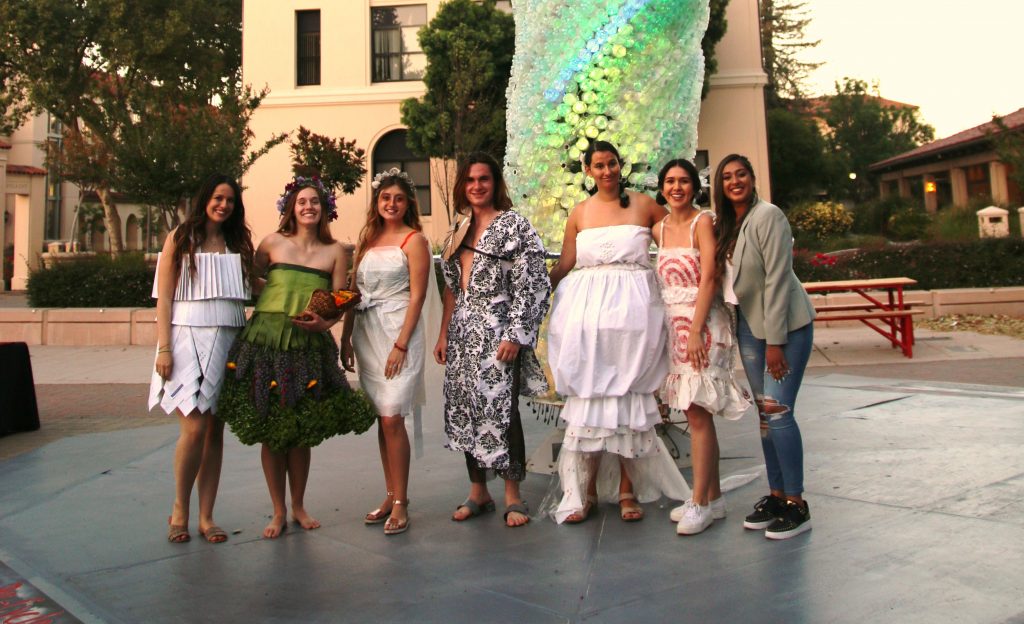Santa Clara University’s Forge Organic Garden team took going green literally in creating its winning entry in Santa Clara University’s 9th Eco-Fashion & Art Show on campus April 25.
“Organic Origins: Rethinking Fashion from the Ground Up,” a two-piece outfit worn by Santa Clara University (SCU) student Julia Jenak, won the honor for the “Most Creative Use of Materials.” The perishable outfit was put together the afternoon of the show, using greenery from the Forge Garden, 1051 Sherman St.
The top was a green banana leaf with fringe, glued to reused cotton fabric and tied in the back with hemp twine. A green skirt with purple floral accents was made of Echium and Euphorbia plants with Calendula flowers, tied together with twine.
Jenak wore a flower crown of lavender, sweet peas and scabiosa. She carried a wicker cornucopia of cut flowers.
Katharine Rondthaler, manager of the Forge Garden, teamed with Zach Gianotti and Jessi Franco to create “Organic Origins.”
“Our team had fun creating a plant-based outfit made from materials we grew,” said Rondthaler. “Our 100 percent organic outfit shed light on the pesticide use on natural fibers in the clothing industry. Conventional cotton uses more pesticides than any other crop.”
“The Eco-Fashion Show has been a wonderful event to engage our campus community in ideas of sustainability,” said SCU Center for Sustainability Director Lindsey Kalkbrenner. “The event itself is quite entertaining while also educational, and invites people to reflect on their own fashion choices and how they impact the environment, economy and social well being of others.”
Kalkbrenner hopes that with greater awareness, people will consider how often they purchase clothes and whether they buy from fashion manufactures that treat their employees and the environment well. People might consider keeping their clothes longer and giving clothes new life through mending, upcycling and donating.
“It’s been 10 years since we started hosting the annual Eco Fashion Show, and the designs keep getting better and better. Designers are not allowed to use new materials — everything has to be made of waste material. They get very creative,” said Kalkbrenner.
Out of seven runway entries this year, the “Most Likely to be Seen at Fashion Week” winner was Eco-Plagiarism by Tay Holliday, modeled by Carina Masenhalder. The dress was made of folded and pleated pages of white paper.
The “Most Likely to be Worn in Real Life” winner was Working Woman by Bevin McCullough. Ruhika Panda modeled torn jeans with a jacket.
“Targeted Waste” was a spaghetti strap sheath with a bottom ruffle. It was made of used plastic bags from Target, creating a human bull’s eye target.
Design partners Ali Deambrosio and Laney Robbins, both SCU juniors, created a two-piece outfit, modeled by Lea Bruzzo Delgadillo, using white plastic trash bags. Delgadillo wore a crown of rosettes made from egg cartons.
“We got together and just started pulling out trash,” said Deambrosio. “We felt excited. It’s a really fun way to showcase sustainability and shed light on the fast fashion industry.”
In the eco-fashion quiz that opened the show, attendees learned that fashion is the second biggest polluter in the world. The Spanish fast fashion retailer Zara has 20 fashion seasons annually.
Attendees viewed the trailer of The True Cost, a 2015 documentary about the human and environmental costs of the fashion industry. View the trailer and tips on shopping smarter at www.truecostmovie.com.
A second video clip focused on the impact of just one cotton t-shirt. It takes a lot of water and energy to produce a t-shirt. Even more water and energy goes into washing and drying it.
The eye-opening eco-fashion show was hosted by the SCU Center for Sustainability (www.scu.edu/sustainability), SCU Presents and the Sustainability Student Advisory Board.
